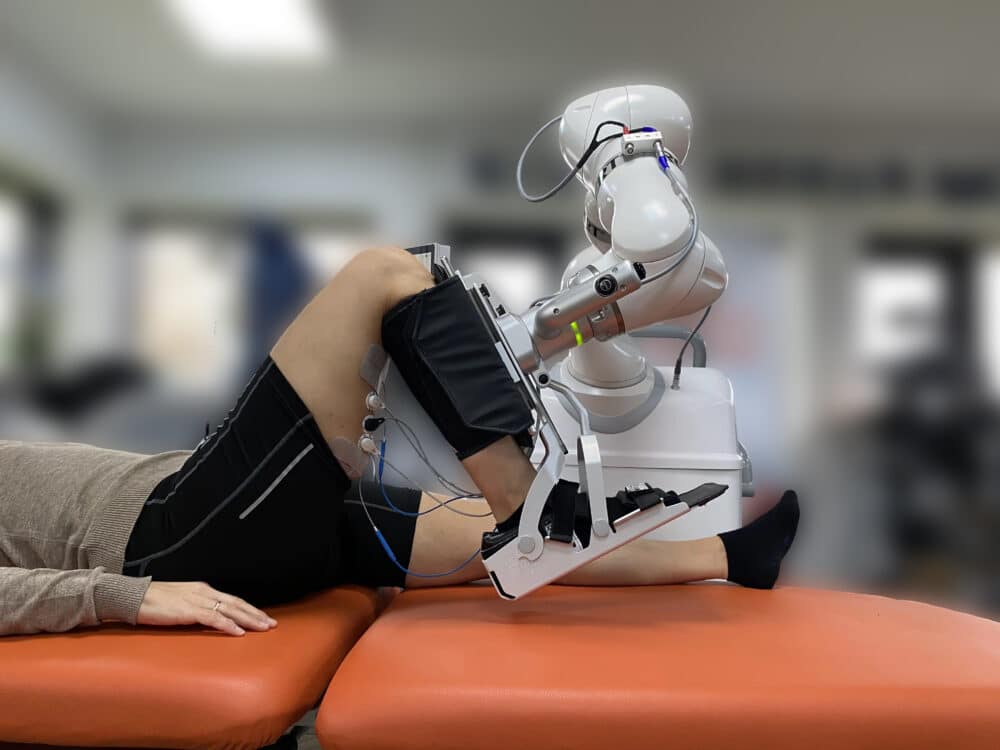
Stroke patients with no mobility can be rehabilitated with unique Danish robotic technology
The Danish robotics company Life Science Robotics has developed a new groundbreaking SAS module for its rehabilitation robot ROBERT®, which now makes it possible to use the robot for intensive rehabilitation even when the patients has completely lost mobility after a stroke, a brain hemorrhage or a spinal cord injury.
“With our new SAS module for ROBERT®, we can help more people regain mobility after a stroke, brain hemorrhage, or spinal cord injury. We have developed a groundbreaking method that combines electrical stimulation with our rehabilitation robot, enabling even patients with severe paralysis to begin targeted, customized, and intensive rehabilitation immediately after a stroke,” says Keld Thorsen, CEO of Life Science Robotics.
SAS module provides help to the patients most in need
Life Science Robotics has had success for several years with its rehabilitation robot ROBERT®, which is already available in several clinics in Denmark, and also present in many other countries worldwide. The tireless Danish robot is used in clinics, hospitals and rehabilitation centers in Europe, Asia and the USA for intensive rehabilitation of patients who have suffered a blood clot in the brain, brain hemorrhage or spinal cord injury.
However, until now, patients needed a certain level of muscle activity to participate in rehabilitation with the robotic system. With the new SAS module, ROBERT® can now also be used to rehabilitate patients who cannot move their legs at all. The SAS module detects signals from the brain and stimulates the muscle fibers through electrodes placed on the patient’s legs.
“The combination of robotic technology and electrical stimulation is unique, offering entirely new possibilities for early, more effective, and measurable rehabilitation for even the most severely affected stroke patients.
Following a stroke, brain hemorrhage, or spinal cord injury, it is crucial for patients to begin intensive and targeted rehabilitation as quickly as possible. With the SAS module integrated with ROBERT®, therapists can initiate intensive rehabilitation immediately after a stroke, even if the patient is not yet able to move their legs,” says Keld Thorsen.
ROBERT® stands in a league of its own globally
The brain controls the body’s movements, and mobility is often lost after a stroke or brain hemorrhage because the brain’s signals are no longer strong enough to activate the body’s muscles following the injury.
The new SAS module is designed to detect and amplify these weak electrical signals from the brain using electrical stimulation, enabling paralyzed patients to move their legs and actively participate in intensive rehabilitation exercises with ROBERT®.
“With the new SAS module, we are elevating our rehabilitation robot to a league of its own among medical rehabilitation equipment. Currently, no other equipment worldwide can train specific joints in both the arms and legs like ROBERT®. With the addition of the SAS module, intensive rehabilitation for even the most severely affected stroke patients can be initiated faster and more effectively than ever before,” says Keld Thorsen.
ROBERT® is a vital tool in rehabilitation at RehabMobility
One of the first places in Denmark using the new SAS module together with ROBERT® is RehabMobility, a neurorehabilitation clinic in Viborg, which is one of the country’s leading private rehabilitation centers for people with acquired brain injury.
At RehabMobility, specialists work daily to rehabilitate patients who have lost mobility due to conditions such as cerebral hemorrhage, stroke, head trauma, or spinal cord injury.
“ROBERT® has become an important training tool in the specialized rehabilitation we provide here at RehabMobility. With the new SAS module, we can now offer intensive, and effective rehabilitation to even more of our clients,” says neurophysiotherapist Helena Rosenberg, project manager and owner of RehabMobility.
The SAS module delivers measurable results.
Rehabilitation at RehabMobility usually involves a high number of repetitions, and this makes ROBERT® indispensable since the robot is tireless, allowing to train the patient’s weakest joints with hundreds of repetitions, precisely tailored to the patient’s specific needs.
ROBERT® enables patients to perform a high amount of repetitions of targeted exercises, which are essential for improving motor functions and rebuilding the brain’s plasticity during recovery.
“With the SAS module, we can combine intensive training with ROBERT® and functional electrical stimulation targeting specific muscle groups that we want to train, something we didn’t have the opportunity to do before. This allows us to offer our patients faster and better rehabilitation,” says Helena Rosenberg
FACTS:
- Life Science Robotics has developed the new SAS module for ROBERT® in collaboration with the Center for Rehabilitation Robotics at the Department of Medicine and Health Technology at Aalborg University and Roessingh Research and Development in the Netherlands. The development of the SAS module has been supported by the EU’s research and innovation program, Eurostars.
- RehabMobility is one of Denmark’s leading private rehabilitation centers for individuals with acquired brain injury. The center focuses on intensive, evidence-based training using welfare technology combined with electrical stimulation for patients living with partial or complete paralysis. RehabMobility provides rehabilitation services to individuals from Denmark and Sweden and offers intensive therapy programs at its facility in Viborg.